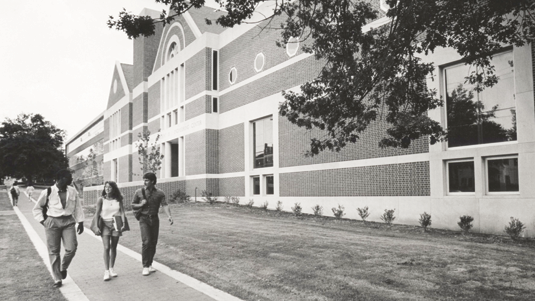
[Continued]
ALUMNI SUPPORT BECOMES CRUCIAL
The university began a major fundraising effort, called “Campaign Auburn: the Next Generation,” in 1994 with a goal of $175 million; when the campaign officially ended in December 1996, the final total exceeded $200 million, and Auburn Engineering shared in its benefits.
As was normal practice, the university initially relied on a small cadre of major donors to kick off the fundraising effort before announcing it publicly. Earle C. Williams ’51, an electrical engineering graduate, was campaign chairman, with John M. Harbert III, ’46 civil engineering, and Ben S. Gilmer, ’26 electrical engineering, serving as honorary chairmen — all three quite successful in business.
However, with Fob James’ return to Montgomery as governor in 1995, the state legislature reduced appropriations for higher education by 7.5 percent, taking Auburn’s budget back to almost the same level as in 1993. Indeed, as it related to state appropriations, the university had flat or lower state funding each year during the first half of the 1990s. As a result, the president cut staff, instituted a hiring freeze and offered early retirements. Most cuts came in administrative and support areas, while academic units experienced small reductions. The president also eliminated overlapping and underutilized curricula, and consolidated smaller programs, which led to vigorous debate.
Brick by brick: Auburn dedicated the John M. Harbert III Engineering Center on April 4, 1986, and a year later Auburn’s Board of Trustees allocated $7.5 million from a state bond issue for the construction of a new aerospace engineering building. Constructed as a second phase of the center, groundbreaking took place on April 29, 1989, in a ceremony punctuated by an F-16 flyover. The building was renamed in 2007 as Charles E. Davis Aerospace Engineering Hall. Despite these additions, the college again found itself short of space. During the summer of 1993, Dean Walker requested nearly $10 million for a major renovation of Wilmore Laboratories, but with tight budgets, construction funding was difficult. Relief would come when the university received a $2 million National Science Foundation renovation grant to make Wilmore “a modern, safe research and teaching engineering facility.” The university committed an initial $2 million to match the NSF grant, a course fee raised $1.7 million, and alumni and corporate donations accounted for another $2.2 million. The building was rededicated in a ceremony in the fall of 1997, with the total project cost at some $12 million; the administration had to rely on additional university funding and alumni donations to close the gap in funding.
PRESSING ISSUE OF FUNDING
Throughout three academic years from 1995 to 1997, state appropriations for higher education in Alabama declined by 6 percent. During the same period, all other southern states increased appropriations for higher education, ranging from a low of 4 percent in Tennessee to a high of 19 percent in Florida, while Georgia increased its appropriations by 11 percent. Auburn continued to suffer financially, leading the dean to write, “Three years ago the College of Engineering stood on the brink of becoming one of the nation’s leading engineering programs. We had the faculty. We had the students. Our facilities, particularly in terms of computing, were making the kind of strides that needed to be made to reach the goals we had placed before ourselves.”
But despite its inability to compete for students with scholarships, cutbacks in student recruiting, faculty salaries that failed to keep pace with other institutions in the region and funding cutbacks for new equipment and facilities, the College of Engineering found ways to stay competitive.
Walker remained concerned about adequate funding for the college, and was quick to point out that many people did not recognize that more than half of Alabama’s economy depended on “manufacturing, space-related research, aerospace production and emerging high-tech industries.”
